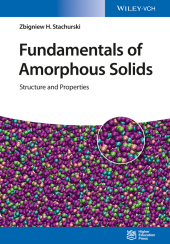 Neuerscheinungen 2015Stand: 2020-02-01 |
Schnellsuche
ISBN/Stichwort/Autor
|
Herderstraße 10
10625 Berlin
Tel.: 030 315 714 16
Fax 030 315 714 14
info@buchspektrum.de |

Zbigniew H. Stachurski
Fundamentals of Amorphous Solids
Structure and Properties
1. Auflage. 2015. XII, 260 S. 244 mm
Verlag/Jahr: WILEY-VCH 2015
ISBN: 3-527-33707-5 (3527337075)
Neue ISBN: 978-3-527-33707-1 (9783527337071)
Preis und Lieferzeit: Bitte klicken
Preface
SPHERES, CLUSTERS AND PACKING OF SPHERES
Introduction
Geometry of Spheres
Geometry of Clusters
Geometry of Sphere Packings
Ideal Amorphous Aolid (IAS)
Construction of an Ideal Amorphous Solid Class I
Elementary Theory of Amorphousness
Classes of Ideal Amorphous Solids
Imperfections in IAS
CHARACTERISTICS OF SPHERE PACKINGS
Geometrical Properties
X-Ray Scattering
Glass Transition Measured by Calorimetry
GLASSY MATERIALS AND IDEAL AMORPHOUS SOLIDS
Introduction
Summary of Models of Amorphous Solids
IAS Model of a-Argon
IAS Model of a-NiNb Alloy
IAS Model of a-MgCuGd Alloy
IAS Model of a-ZrTiCuNiBe Alloy
IAS Model of a-Polyethylene (a-PE)
IAS Model of a-Silica (a-SiO2)
Chalcogenide Glasses
Concluding Remarks
MECHANICAL BEHAVIOUR
Introduction
Elasticity
Elastic Properties of Amorphous Solids
Fracture
Plasticity
Plasticity in Plasticity: Amorphous Solids
Superplasticity
Viscoelasticity
Index
Adopting a unique approach, this textbook meets the long-felt need for convincing concepts to describe amorphous solids. It replaces vague notions of amorphous materials as disordered crystalline solids with the well-founded concept of ideal amorphous solids.
Long awaited, this textbook fills the gap for convincing concepts to describe amorphous solids.
Adopting a unique approach, the author develops a framework that lays the foundations for a theory of amorphousness. He unravels the scientific mysteries surrounding the topic, replacing rather vague notions of amorphous materials as disordered crystalline solids with the well-founded concept of ideal amorphous solids. A classification of amorphous materials into inorganic glasses, organic glasses, glassy metallic alloys, and thin films sets the scene for the development of the model of ideal amorphous solids, based on topology- and statistics-governed rules of three-dimensional sphere packing, which leads to structures with no short, mid or long-range order. This general model is then concretized to the description of specific compounds in the four fundamental classes of amorphous solids, as well as amorphous polyethylene and poly(methyl)methacrylate, emphasizing its versatility and descriptive power. Finally, he includes example applications to indicate the abundance of amorphous materials in modern-day technology, thus illustrating the importance of a better understanding of their structure and properties.
Equally ideal as supplementary reading in courses on crystallography, mineralogy, solid state physics, and materials science where amorphous materials have played only a minor role until now.
Zbigniew H. Stachurski is Professor in the College of Engineering and Computer Science and a past Director of the Centre for the Science and Engineering of Materials at the Australian National University in Canberra (Australia). He obtained his MSc in Mechanical Engineering from the AGH University of Science and Technology in Krakow (Poland) and his PhD in Physics of Materials from the University of Bristol (UK). He was research fellow at the Universities of Alberta (Canada), Leeds (UK), Melbourne and CSIRO (Australia) before becoming Reader at the Australian National University. Zbigniew H. Stachurski´s research interests include the structure and physical properties of solids in general and more recently the theory of atomic arrangements in amorphous solids in particular.


